
Let’s Ask Marion Nestle: Could The USDA Get Any Cheesier?
| Eating Liberally’s kat (a.k.a. Kerry Trueman) asks one of her inimitable “Ask Marion” questions, this one about Michael Moss’s blockbuster story in today’s New York Times about dairy lobbying.
* KT: Sunday’s New York Times has a disturbing exposé by Michael Moss about the USDA’s efforts to aid the dairy industry by encouraging excessive cheese consumption. Can the USDA ever reconcile its two mandates? On the one hand, the USDA has the task of tackling the obesity epidemic by encouraging healthier eating habits. Yet it must also promote the interests of U.S. agriculture. As Moss documents so well, these two missions are in total conflict. Dr. Nestle: And so they are, have been, and will be until public outrage causes some changes in Washington. In two of my books, Food Politics and What to Eat, I wrote about how dairy lobbying groups, aided and abetted by the The USDA is still at it. As Michael Moss notes:
So let’s talk about “moderation,” a word that I find hard to use without irony. The pizza illustrated in Michael Moss’s article is described as a “thin-crust medium pie.” The diameter is not given, but one-fourth of the pie contains 430 calories, 12 grams of saturated fat (20 is the daily recommended upper limit), and 990 mg sodium (the upper limit is 2,300). Who eats one-quarter of a pizza? Not anyone I know. So double all this if you share it with a friend. If you eat the whole thing–and why do I think that plenty of Domino Pizza customers do?–you are consuming more than 1700 calories, nearly 4,000 mg sodium (that’s 10 grams of salt, by the way), and 48 grams of saturated fat. This is enough to make any nutritionist run screaming from the room. So why is USDA in bed with dairy lobbying groups? That’s its job. From its beginnings in the 1860s, USDA’s role was to promote U.S. agricultural production and sales, with the full support of what was then a largely agricultural Congress. Only in the 1970s, did USDA pick up all those pesky food assistance programs and capture the “lead federal agency” role in providing dietary advice to the public. Much of Food Politics is devoted to describing the USDA’s severe conflict of interest in developing dietary advice to “eat less” of basic agricultural commodities. As Times reporter Marian Burros put it in one of her articles about the fights over the 1992 Pyramid, which visually suggested eating less meat and dairy, “the foxes are This is what Mrs. Obama is up against in her efforts to reduce childhood obesity and bring healthier foods into America’s inner cities. How to change this system? One possibility might be to move dietary guidance into a more independent federal agency, NIH or CDC for example. Another might be to recognize the ways in which corporate lobbyists corrupt our food system and do something about election campaign laws. A pipe dream? Maybe, but I never thought I’d live to see the editors of the New York Times consider an article about USDA checkoff programs to be front-page news, and in the right-hand column yet, marking it as the most important news story of the day. |

